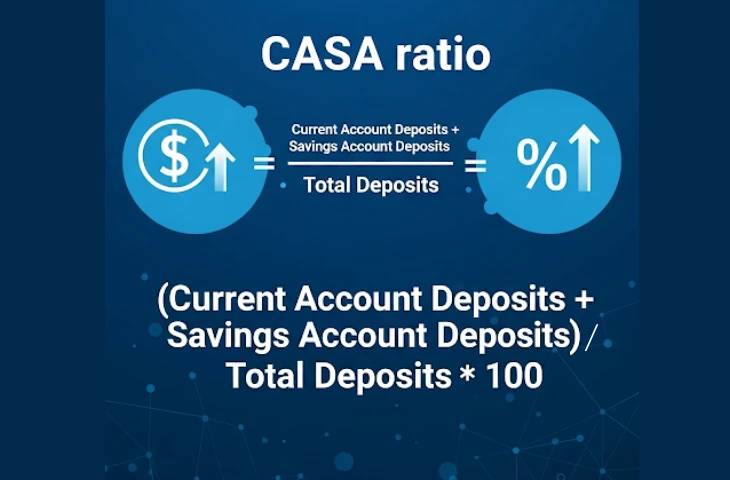CASA Ratio: Banking exams in India often test a candidate’s awareness of basic financial concepts, and one of the most frequently asked topics is CASA Ratio. Understanding this concept not only helps in answering exam questions but also equips aspirants with practical insights into how banks function. Let’s understand about the CASA ratio in this article.
What is CASA in banking?
CASA is an abbreviation for Current Account and Savings Account. These two types of deposits form the backbone of a bank’s low-cost funds. Customers deposit their money either in a savings account (mainly individuals who wish to earn small interest while enjoying safety and liquidity) or a current account (mainly businesses that need frequent, high-volume transactions without any interest benefit).
For banks, CASA deposits are attractive because they are either interest-free (current account) or carry a relatively low interest rate (savings account). This reduces the bank’s cost of funds compared to term deposits or borrowings. That’s why CASA Ratio is one of the most Important Banking Awareness Terms.
How Does CASA Work in the Banking Sector?
When customers keep money in these accounts, the bank gets access to funds at minimal cost. The bank then uses these funds for lending activities like home loans, personal loans, or business loans at a much higher interest rate.To understand CASA, think of it as money that is always “on call.”
- Savings Account: Customers deposit money, earn modest interest, and can withdraw at any time. For individuals, this is the most common deposit type.
- Current Account: Businesses, traders, and corporates keep funds here to manage daily transactions. There is usually no interest offered, but banks provide overdraft facilities, checkbooks, payment gateways, and other services.
CASA Ratio Formula
The CASA ratio shows the proportion of deposits that a bank holds in current and savings accounts compared to its total deposits. The formula to calculate CASA Ratio is shared below:
CASA Ratio Formula: CASA = Current Deposits + Savings Deposits / Total Deposits × 100
For example, if a bank has ₹1,00,000 crore in deposits, and out of this, ₹40,000 crore is in current and savings accounts, then its CASA ratio is 40%. A higher CASA ratio means the bank has access to cheaper funds, giving it an advantage in profitability.
How is the CASA ratio calculated?
To understand how the CASA ratio works, let’s look at the example below:
- Current Account Deposits: ₹20,000 crore
- Savings Account Deposits: ₹30,000 crore
- Total Deposits: ₹1,00,000 crore
CASA Ratio=20,000+30,000/100,000×100=50%CASA/Ratio = \frac{20,000 + 30,000}{100,000} \times 100 = 50\% CASA Ratio=100,000/(20,000+30,000)×100=50%
This means half of the bank’s deposits are in low-cost accounts. This is considered a healthy sign because the bank doesn’t have to pay much interest on such deposits.
Why Is the CASA Ratio Important for Banking Aspirants?
For a banking aspirant, understanding the CASA ratio is crucial for multiple reasons:
- Exam Relevance: Questions about CASA Ratio, its meaning, formula, or numerical application are frequently asked in banking exams.
- Interview Value: In interviews, aspirants may be asked to explain why banks run “CASA campaigns” or why CASA is an important performance metric. Knowing the answer shows practical awareness.
- Understanding Banking Business: CASA explains how banks manage funds, reduce costs, and stay competitive. Aspirants who understand this can also write better essays and letters in descriptive papers.
How to Understand CASA Trends for Today’s Market?
For anyone tracking banks—whether as an investor, student, or job aspirant—CASA trends are key indicators.
- Rising CASA Ratio: Indicates customers are trusting the bank with more low-cost deposits. This usually improves profitability.
- Falling CASA Ratio: Could mean customers are shifting money into fixed deposits (for higher returns) or moving funds to competitors.
- Digital Banking Influence: UPI, salary accounts, and mobile banking have made it easier for banks to capture CASA deposits.
- Interest Rate Cycle: In high interest rate periods, customers prefer FDs, which can lower CASA ratios.
CASA Ratio-Related Questions for Bank Exams
Here are some practice questions for CASA Ration for banking exam aspirants:
- What does CASA stand for in banking?
(a) Credit and Savings Account
(b) Current and Savings Account
(c) Corporate and Security Account
(d) Capital and Surplus Account
Answer: (b)
- CASA Ratio is used to measure which of the following?
(a) Profitability of banks
(b) Proportion of low-cost deposits
(c) Market share of banks
(d) Lending capacity of banks
Answer: (b)
- If Bank A has total deposits of ₹2,50,000 crore, with savings deposits of ₹60,000 crore and current deposits of ₹40,000 crore, what is the CASA Ratio?
(a) 25%
(b) 40%
(c) 50%
(d) 60%
Answer: (b) 40%
- Why do banks launch CASA campaigns?
(a) To reduce NPAs
(b) To increase low-cost deposits and improve margins
(c) To attract foreign investors
(d) To comply with RBI guidelines
Answer: (b)
- In which part of the banking exam is CASA Ratio most likely to be asked?
(a) Quantitative Aptitude
(b) Banking Awareness / General Awareness
(c) Reasoning Ability
(d) Computer Awareness
Answer: (b)
- Which of the following deposits is considered a part of CASA?
(a) Fixed Deposits only
(b) Current and Savings Deposits
(c) Recurring Deposits and Term Deposits
(d) Certificates of Deposit
Answer: (b)
- Which of the following is NOT true about CASA accounts?
(a) They are demand deposits
(b) They reduce banks’ cost of funds
(c) They always carry high interest rates
(d) They improve liquidity for banks
Answer: (c)
- If a bank has ₹1,00,000 crore in total deposits, and ₹35,000 crore in savings deposits, and ₹15,000 crore in current deposits, what is the CASA Ratio?
(a) 35%
(b) 40%
(c) 45%
(d) 50%
Answer: (c) 50%
- CASA deposits are considered beneficial for banks because:
(a) They provide long-term fixed funds
(b) They come at a low cost
(c) They are given only to corporates
(d) They are free of RBI regulation
Answer: (b)
- Which of the following is generally TRUE about current accounts?
(a) They carry no interest
(b) They are primarily used by businesses
(c) They allow unlimited transactions
(d) All of the above
Answer: (d)
- Which of the following best describes a high CASA Ratio?
(a) Bank depends heavily on term deposits
(b) Bank has more access to low-cost deposits
(c) Bank is unable to mobilize retail deposits
(d) Bank has lower liquidity
Answer: (b)
- If CASA deposits of a bank = ₹80,000 crore and total deposits = ₹2,00,000 crore, what is the CASA Ratio?
(a) 35%
(b) 40%
(c) 45%
(d) 50%
Answer: (d) 40%
- Which type of bank generally maintains a higher CASA Ratio?
(a) Cooperative Banks
(b) Public Sector Banks
(c) Small Finance Banks
(d) Both (b) and (c) depending on customer base
Answer: (d)
- Which of the following affects CASA Ratio negatively?
(a) Higher interest rates on fixed deposits
(b) Growth in digital payment systems
(c) Increase in salary accounts
(d) Strong corporate tie-ups
Answer: (a)
- In banking terms, CASA deposits are also called:
(a) Fixed liabilities
(b) Demand deposits
(c) Time deposits
(d) Market borrowings
Answer: (b)
FAQs
Ans: The CASA ratio indicates how much of a bank’s deposits come from low-cost sources like current and savings accounts. A higher ratio means the bank can raise funds at a cheaper cost, which directly boosts its profitability and competitiveness.
Ans: There is no fixed benchmark, but generally, a CASA ratio of 35–45% or higher is seen as healthy for Indian banks. It suggests that the bank has a strong base of low-cost deposits, ensuring stable and cheaper funding.
Ans: No, CASA ratios differ across banks. Public sector banks often have higher CASA ratios due to their large branch network and trust among depositors, while private and small finance banks may focus more on fixed deposits and other products.
Ans: While customers don’t directly see the CASA ratio, it indirectly benefits them. A bank with a higher CASA ratio has lower funding costs and can offer competitive interest rates on loans, along with better services and digital banking facilities.
Ans: Yes. If a bank’s fixed deposits (FDs) grow faster than its savings or current deposits, the CASA ratio will decline, even though total deposits are rising. This often happens when FD interest rates are attractive compared to savings accounts.
- PNB LBO Syllabus and Exam Pattern 2025, Check Details

- PNB LBO Salary 2025, In Hand Salary, Perks, and Allowances

- Bank of Baroda LBO Group Discussion, Topic List, Complete Guide

- Bank of Baroda LBO LPT, State-wise Languages & Full Details

- Bank of Baroda LBO Interview Questions and Answers, Download FREE PDF

- IBPS Clerk Vacancy 2025 Increased upto 15701, Check Details

Hi, I’m Tripti, a senior content writer at Oliveboard, where I manage blog content along with community engagement across platforms like Telegram and WhatsApp. With 3+ years of experience in content and SEO optimization related to banking exams, I have led content for popular exams like SSC, banking, railways, and state exams.
